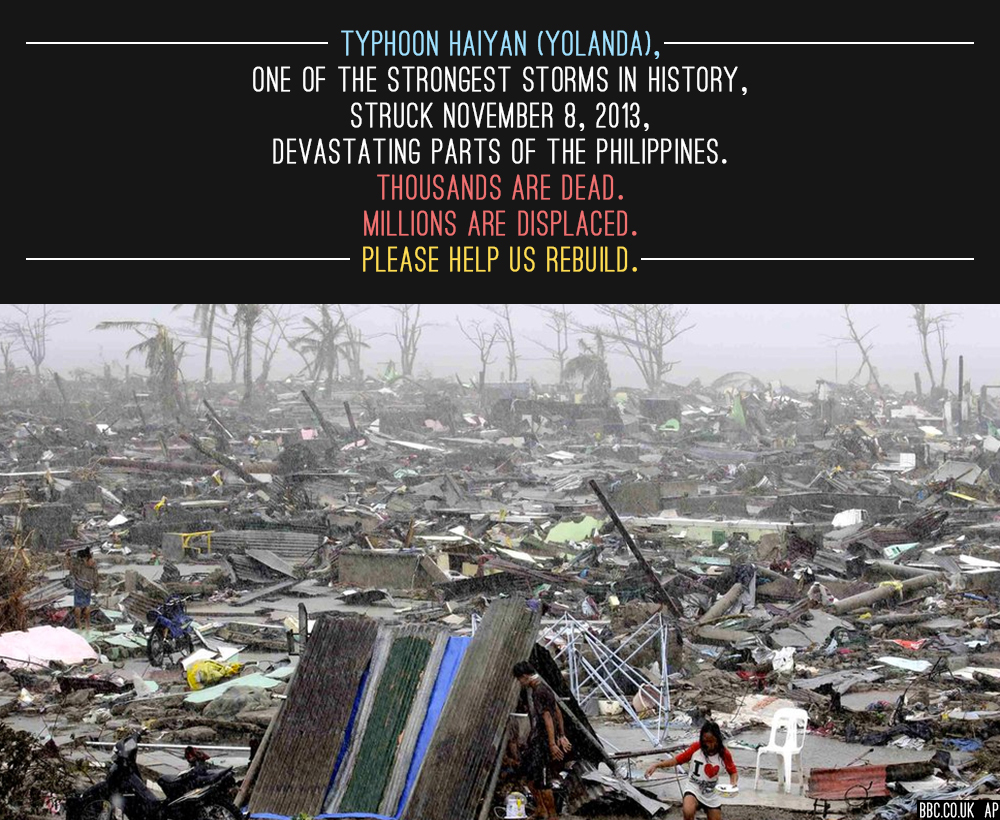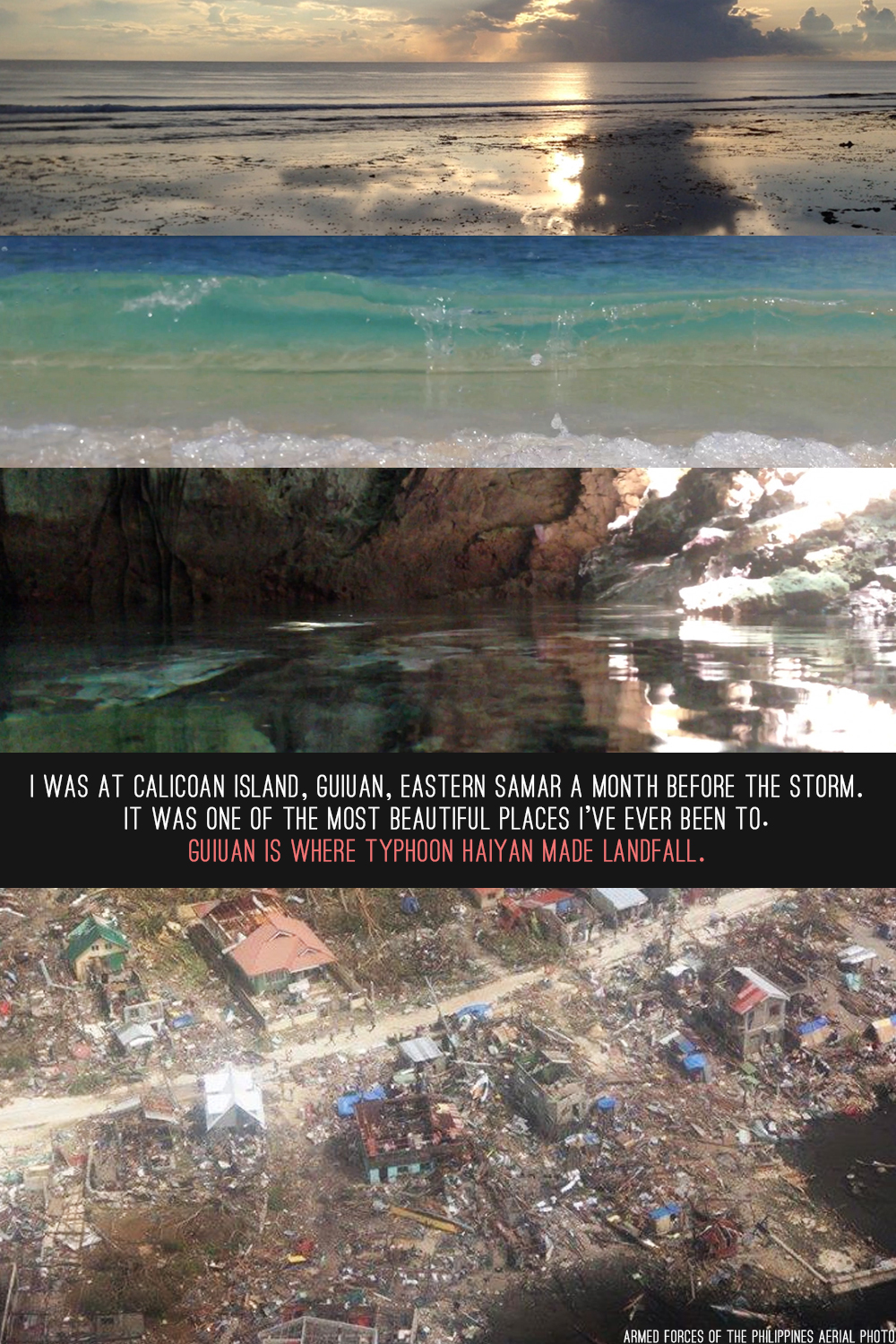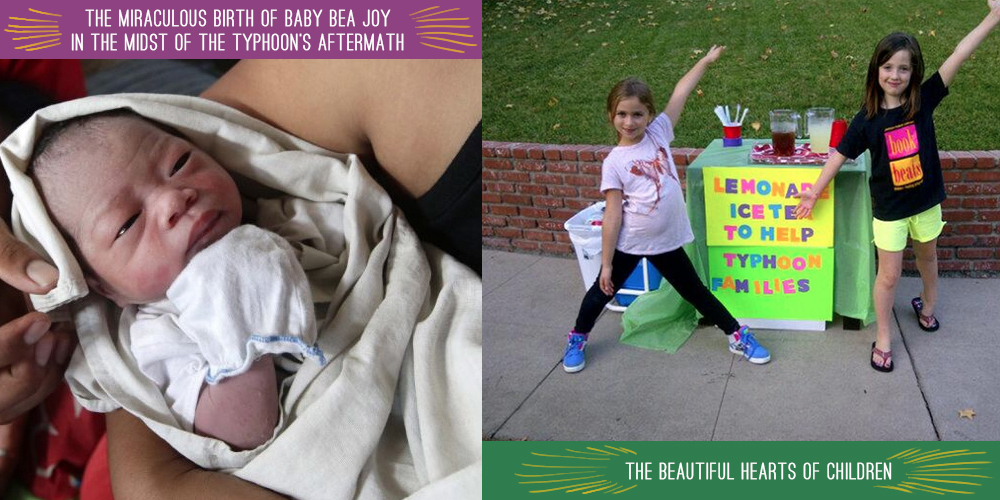What Do You Do When The Strongest Storm Of The Year (Typhoon Haiyan) Devastates Your Country?
/
Typhoon Haiyan has devastated our country and we need your help.

I canceled my plans for the day and stayed home. Memories of flying debris during previous years’ supertyphoons made me decide that I didn’t want to take any chances. On the news, they were calling it the strongest storm of the year. They showed satellite pictures of that monstrous spiral, spinning our way. Last year, we were caught by surprise when a low pressure area— not even a typhoon— dumped enough rainfall on Metro Manila to cause serious flooding. So we stocked up on drinking water and waited for the rain. It poured down intermittently from a gloomy gray sky. As night fell, I listened to the wind howling outside. I thought it would get worse, but it didn’t. Metro Manila wasn’t in the typhoon’s predicted path, and we were spared any sudden surprises. It was only later that we would receive the horrifying news from Visayas, which bore the brunt of the storm’s fury.
The Philippines is a tropical archipelago in the Pacific ring of fire, making it prone to earthquakes, volcano eruptions, and typhoons. It’s divided into three main islands: Luzon in the north, Mindanao in the south, and Visayas in the center. Typhoon Haiyan tore through this center barely a month after a 7.2 earthquake struck a Visayas province. Our country’s vulnerability is amplified by widespread poverty, lack of infrastructure, weak disaster management capabilities, and systemic corruption. It is surreal that the year’s strongest storm struck on the very day after the year’s biggest corruption scandal, which involves an estimated 10 billion pesos worth of Filipino taxpayers’ money, and includes the alleged theft of 20 million dollars of relief funds meant for last year’s flood victims. Dr. Diane Desierto has outlined the opportunity costs of corruption in Corruption: Preying on PH resilience and faith:
OUR lost public funds could have been spent towards our regular reconstruction efforts, for rebuilding our schools, our communities. While natural disasters are not directly preventable (climate change has its own stamp on the frequency of these disasters), their consequences can be remediated, mitigated, and allayed. The technology exists at a price – Honolulu, Venice, the Netherlands are but 3 places around the world where anti-flooding systems, early warning mechanisms, and other disaster coping mechanisms are well in place – but corruption has made accessing those technologies lost opportunity costs.
I consider the fight against corruption to be an integral part of rebuilding our country and mitigating the impact of future natural calamities.

Guiuan in Eastern Samar was the first to be struck. I was at Calicoan Island in Guiuan in October, and it is one of the most beautiful places I’ve ever been to. I splashed in clean blue Pacific seawater, enjoyed the best “uni” sashimi I’ve ever had after gathering my own sea urchins from the beach, and trekked through the jungle to behold the deep, crystal-clear turquoise waters at a large cave pool called “Lake Linaw”. Surfers rank the waves at Calicoan to be right up there with Hawaii. I’ve seen those “double overhead” waves pounding on that reef break— and, though I haven’t gotten up close like my surfer friends— I’ve been tossed around by that powerful current even while just wading in waist deep water near the shore. Under sunny weather, those waves pack a punch. I can only imagine how it must have been during the storm. I don’t know how to reconcile my happy memories of that island paradise with today’s images of death and destruction there.
On a good day, Calicoan Island in Guiuan is a 3 to 4 hour bumpy van ride away from Tacloban City in Leyte, which is receiving the most media and relief attention. After the storm, it took 16 hours on motorbike for local reporter David Santos and his cameraman to reach Tacloban from Guiuan. The Philippine army posted aerial photos showing the destruction of Guiuan, but we don’t know anything else. We’re still waiting for further information. We haven’t yet heard from the resort staff at the beach we went to in Calicoan.

The deadly storm surge swept a ship onto land, ripped apart concrete structures, and pulled children out of their parents’ arms. Air force commander Lieutenant Colonel Fermin Carangan was carried out to open sea in the flood, along with 7-year-old Miguel, and they were miraculously rescued after drifting for 6 hours. Lt. Col. Carandang recounted the flood’s rush:
Suddenly the building collapsed and I saw my men falling into the surging water and very strong winds. There was also no more roof on top of the building. I was able to hold on to a piece of wood – a truss which I forcibly removed just before I was taken by waves and the strong current… I saw one of my soldiers trying to hold on to an uncollapsed wall of another destroyed building. I tried to reach for him but the current was too strong and there was confusion and hysteria.
Caught in the same flood, a high school teacher’s daughter gave her last words: “Ma, just let go. Save yourself.” Those who escaped death are now fighting for their lives, without food, clean water, shelter, medicine, power, and communication. My friend Aya is there right now, writing about the aftermath, reporting that corpses are hanging to trees and people are resorting to scavenging and looting. “I am a decent person. But if you have not eaten in three days, you do shameful things to survive,” said Mr. Gualberto as he scavenged what he could amidst debris and dead bodies. “This typhoon has stripped us of our dignity… but I still have my family and I am thankful for that.” The iron-fisted Mayor Duterte of Davao City, Mindanao, was emotional as he surveyed Tacloban’s damage: “I think God was somewhere else when the typhoon hit… There is no Tacloban city right now.”

The UN estimated that we need over 300 million US dollars, to help over 11 million people get back on their feet. We have a long way to go, and every bit of help counts.
I am saddened to learn about Paypal freezing the account of my friend Anna Opposa, the head of Save Philippine Seas, who was collecting donations for Malapascua. This is unacceptable. I understand Paypal is fighting money laundering, but at this time of calamity, it is unthinkable that Paypal doesn’t have even one or two employees to proactively monitor local relief efforts and make sure that the online payment gateway is a help and not a bottleneck. However, it does remain to be the single most convenient way to receive funds from abroad. Xoom, a Paypal alternative, has just announced that they will donate all transfer fees for donations to Philippine Red Cross. I haven’t tried Xoom yet, so if you have, please let us know your feedback.
I am so grateful to Anne for helping me reach out to you about my country’s crisis. Please spread the word, and check back on this article for ongoing updates.
In the midst of darkness, there is hope. We are overwhelmed by the outpouring of sympathy and help from people all over the world. My heart is warmed by stories of people helping each other out, in whatever ways they can. On 8 Inspiring Yolanda/Haiyan Stories I learned about a baby girl who was born in the midst of the aftermath, and I saw two little girls in America putting up a lemonade stand for the benefit of typhoon victims.

There are many ways to help. By far, the easiest way to help from abroad would be to send money to a large and reliable organization such as the Philippine Red Cross. I would also like to highlight the need for sustainable relief effort that will improve health, reduce waste, help the environment, and restore livelihood opportunities in order to help people in the long-term. Specifically, that means reducing single-use plastic materials, using nutrient-dense low-cost practical local foods, using clever multipurpose items, and empowering people with clean technology and the means for them to begin rebuilding. I have put together a list of sustainable relief efforts, some of which are by my friends, and one that I’ve co-organized with an artist friend.
Sustainable Relief Efforts For Typhoon Haiyan Victims
Gawad Kalinga and Habitat For Humanity are both about empowering locals to rebuild their own communities.
Green ReLeaf is about long-term sustainable rebuilding, deploying seedlings to help families rebuild their farms and gardens of edible veggies.
Save Philippine Seas, a marine environment preservation org run by my friend, “chief mermaid” Anna Opposa, is raising funds for Malapascua in Northern Cebu.
WakaWaka Solar Lamps: buy one, give one to the Philippines.
Waves For Water will be delivering compact portable water filtration systems thru the Romualdez foundation.
Shelter Of Hope, affordable tent donations for typhoon victims— from Volunteers of Simbahang Lingkod Ng Bayan, Ateneo De Manila University. (Facebook link)
Malong Ni Mama, by Hannah Liongoren and me, focusing on using local multipurpose health-promoting products with less wasteful packaging, for Guiuan, Eastern Samar. (Facebook link)
Lists Of More Ways To Help Typhoon Haiyan Victims
CNN - How to help Typhoon Haiyan survivors
Huffingtonpost - How To Help Typhoon Haiyan Survivors
Rappler - #ReliefPH: Victims of Typhoon Yolanda (Haiyan) need your help
Donating to the Philippines from abroad (2013 typhoon Haiyan / Yolanda)
How To Help Locally And From Abroad
Typhoon Haiyan Stories & Pictures
#RescuePH #ReliefPH and #YolandaPH: What’s going on, what you can do (continuing updates)
NY Times - Pictures of Typhoon Haiyan’s Wrath
CNN - Typhoon Haiyan crushed town ‘like giant hand from the sky’
BBC - In pictures: Philippines struggle for survival
Time - Typhoon Haiyan Cuts a Path of Destruction Across The Philippines
~ Feanne